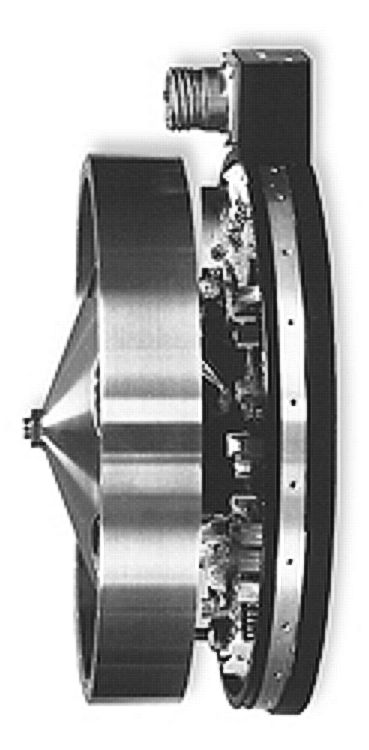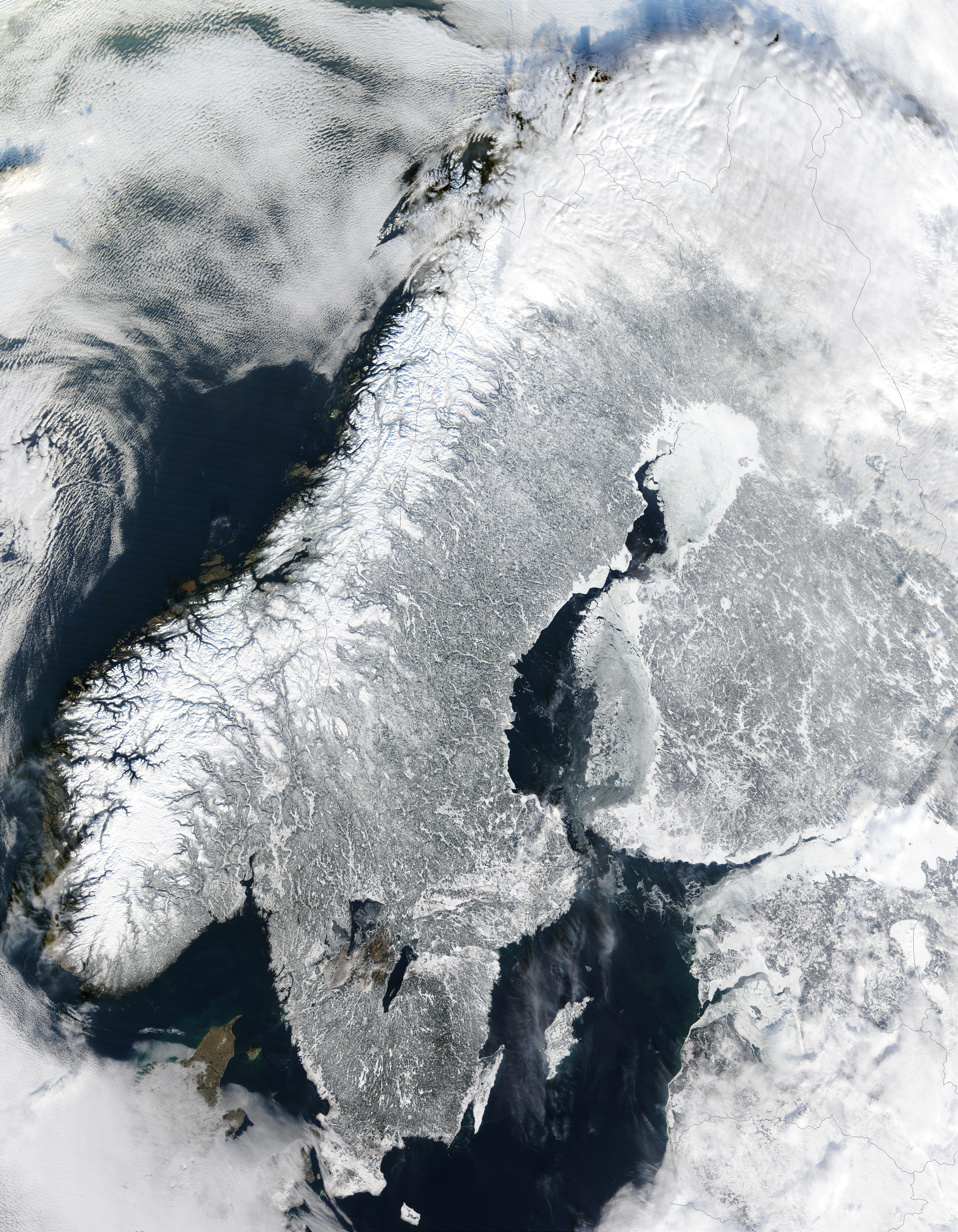|
SUNSAT
The Stellenbosch UNiversity SATellite or SUNSAT (COSPAR 1999-008C) was the first miniaturized satellite designed and manufactured in South Africa. It was launched aboard a Delta II rocket from the Vandenberg Air Force Base on 23 February 1999 to become the first launched South African satellite. Sunsat was built by post-graduate engineering students at the University of Stellenbosch. Its AMSAT designation was SO-35 (Sunsat Oscar 35). Last contact by ground control with SUNSAT was on 19 January 2001 and on 1 February 2001 the end of SUNSAT's functional life in orbit was announced. The satellite operated in orbit for nearly 2 years. It is predicted to reenter the atmosphere after about 30 years from launch. Specifications SUNSAT satellite specifications: * Size: 45 x 45 x 60 cm * Mass: 64 kg * Launcher: Delta II rocket, Mission P-91 * Program cost: US $5M (Approximate); the launch was free of charge as SUNSAT was orbited as a secondary payload. The primary payload of the ... [...More Info...] [...Related Items...] OR: [Wikipedia] [Google] [Baidu] [Amazon] |
|
 |
Stellenbosch University
Stellenbosch University (SU) (, ) is a public research university situated in Stellenbosch, a town in the Western Cape province of South Africa. Stellenbosch is the oldest university in South Africa and the oldest extant university in Sub-Saharan Africa, which received full university status in 1918. Stellenbosch University designed and manufactured Africa's first microsatellite, SUNSAT, launched in 1999. Stellenbosch is organised in 139 departments across 10 faculties offering bachelor's (Education in South Africa#Higher education and training system, NQF 7) to doctoral degrees (NQF 10) in the English and Afrikaans language. Across five campuses in the Western Cape, the university is home to 32,000 students. The students of Stellenbosch University are nicknamed "Maties". The term probably arises from the Afrikaans word "tamatie" (meaning tomato, and referring to the maroon sports uniforms and blazer colour). An alternative theory is that the term comes from the Afrikaans colloq ... [...More Info...] [...Related Items...] OR: [Wikipedia] [Google] [Baidu] [Amazon] |
|
ARGOS (satellite)
The Advanced Research and Global Observation Satellite (ARGOS) was launched on 23 February 1999 carrying nine payloads for research and development missions by nine separate researchers. The mission terminated on 31 July 2003. ARGOS was launched from SLC-2W, Vandenberg Air Force Base, California, atop a Boeing Delta II (7920-10) launch vehicle. Construction of the spacecraft bus and integration of the satellite's payloads was accomplished by Boeing at their Seal Beach, California facility. The program was funded and led by the DoD's Space Test Program (STP) as mission P91-1 (the first STP mission contract awarded in 1991). The US$220 million mission was operated by Air Force Space Command's Space and Missile Systems Center's Test and Evaluation Directorate (then Space Development and Test Wing, now SMC's Advanced Systems and Development Directorate) from their RDT&E Support Complex (RSC) at Kirtland Air Force Base, New Mexico. ARGOS was the first mission operated 100% from ... [...More Info...] [...Related Items...] OR: [Wikipedia] [Google] [Baidu] [Amazon] |
|
|
Ørsted (satellite)
Ørsted is an Earth science satellite launched in 1999 to study the Earth's geomagnetic field. It is Denmark's first satellite, named after Hans Christian Ørsted (1777–1851), a Danish physicist and professor at the University of Copenhagen, who discovered electromagnetism in 1820. Objectives The spacecraft's primary science objectives are to perform highly accurate and sensitive measurements of the geomagnetic field and to perform global monitoring of the high energy charged particle environment. Instruments The instrumentation consisted of two magnetometers ( proton precession and fluxgate), a star imager for attitude determination, a solid-state charged particle detector package, and a GPS receiver. The Science Instrument Team is responsible for the design of the instruments, while the Science Team is responsible for the science mission planning and international science participation. The science data obtained during the planned one-year mission will be used to derive ... [...More Info...] [...Related Items...] OR: [Wikipedia] [Google] [Baidu] [Amazon] |
|
 |
Miniaturized Satellite
A small satellite, miniaturized satellite, or smallsat is a satellite of low mass and size, usually under . While all such satellites can be referred to as "small", different classifications are used to categorize them based on mass. Satellites can be built small to reduce the large economic cost of launch vehicles and the costs associated with construction. Miniature satellites, especially in large numbers, may be more useful than fewer, larger ones for some purposes – for example, gathering of scientific data and radio relay. Technical challenges in the construction of small satellites may include the lack of sufficient power storage or of room for a propulsion system. Rationales One rationale for miniaturizing satellites is to reduce the cost; heavier satellites require larger rockets with greater thrust that also have greater cost to finance. In contrast, smaller and lighter satellites require smaller and cheaper launch vehicles and can sometimes be launched in mult ... [...More Info...] [...Related Items...] OR: [Wikipedia] [Google] [Baidu] [Amazon] |
 |
Reaction Wheels
A reaction wheel (RW) is an electric motor attached to a flywheel, which, when its rotation speed is changed, causes a counter-rotation proportionately through conservation of angular momentum. A reaction wheel can rotate only around its center of mass; it is not capable of moving from one place to another ( translational force). Reaction wheels are used primarily by spacecraft for three-axis attitude control, and do not require rockets or external applicators of torque, which reduces the mass fraction needed for fuel. They provide a high pointing accuracy, and are particularly useful when the spacecraft must be rotated by very small amounts, such as keeping a telescope pointed at a star. A reaction wheel is sometimes operated at a constant (or near-constant) rotation speed, to provide a satellite with a large amount of stored angular momentum. Doing so alters the spacecraft's rotational dynamics so that disturbance torques perpendicular to one axis of the satellite (the axis p ... [...More Info...] [...Related Items...] OR: [Wikipedia] [Google] [Baidu] [Amazon] |
 |
Spacecraft Launched By Delta II Rockets
A spacecraft is a vehicle that is designed to fly and operate in outer space. Spacecraft are used for a variety of purposes, including communications, Earth observation, meteorology, navigation, space colonization, planetary exploration, and transportation of humans and cargo. All spacecraft except single-stage-to-orbit vehicles cannot get into space on their own, and require a launch vehicle (carrier rocket). On a sub-orbital spaceflight, a space vehicle enters space and then returns to the surface without having gained sufficient energy or velocity to make a full Earth orbit. For orbital spaceflights, spacecraft enter closed orbits around the Earth or around other celestial bodies. Spacecraft used for human spaceflight carry people on board as crew or passengers from start or on orbit (space stations) only, whereas those used for robotic space missions operate either autonomously or telerobotically. Robotic spacecraft used to support scientific research are space prob ... [...More Info...] [...Related Items...] OR: [Wikipedia] [Google] [Baidu] [Amazon] |
 |
Spacecraft Launched In 1999
A spacecraft is a vehicle that is designed to fly and operate in outer space. Spacecraft are used for a variety of purposes, including communications, Earth observation, meteorology, navigation, space colonization, planetary exploration, and transportation of humans and cargo. All spacecraft except single-stage-to-orbit vehicles cannot get into space on their own, and require a launch vehicle (carrier rocket). On a sub-orbital spaceflight, a space vehicle enters space and then returns to the surface without having gained sufficient energy or velocity to make a full Earth orbit. For orbital spaceflights, spacecraft enter closed orbits around the Earth or around other celestial bodies. Spacecraft used for human spaceflight carry people on board as crew or passengers from start or on orbit (space stations) only, whereas those used for robotic space missions operate either autonomously or telerobotically. Robotic spacecraft used to support scientific research are space probes ... [...More Info...] [...Related Items...] OR: [Wikipedia] [Google] [Baidu] [Amazon] |
 |
Amateur Radio Satellites
An amateur () is generally considered a person who pursues an avocation independent from their source of income. Amateurs and their pursuits are also described as popular, informal, self-taught, user-generated, DIY, and hobbyist. History Historically, the amateur was considered to be the ideal balance between pure intent, open mind, and the interest or passion for a subject. That ideology spanned many different fields of interest. It may have its roots in the ancient Greek philosophy of amateur athletes competing in the Olympics. The ancient Greek citizens spent most of their time in other pursuits, but competed according to their natural talents and abilities. The "gentleman amateur" was a phenomenon among the gentry of Great Britain from the 17th century until the 20th century. With the start of the Age of Reason, with people thinking more about how the world works around them, (see science in the Age of Enlightenment), things like the cabinets of curiosities, and the wri ... [...More Info...] [...Related Items...] OR: [Wikipedia] [Google] [Baidu] [Amazon] |
|
NASA
The National Aeronautics and Space Administration (NASA ) is an independent agencies of the United States government, independent agency of the federal government of the United States, US federal government responsible for the United States's civil list of government space agencies, space program, aeronautics research and outer space, space research. National Aeronautics and Space Act, Established in 1958, it succeeded the National Advisory Committee for Aeronautics (NACA) to give the American space development effort a distinct civilian orientation, emphasizing peaceful applications in space science. It has since led most of America's space exploration programs, including Project Mercury, Project Gemini, the 1968–1972 Apollo program missions, the Skylab space station, and the Space Shuttle. Currently, NASA supports the International Space Station (ISS) along with the Commercial Crew Program and oversees the development of the Orion (spacecraft), Orion spacecraft and the Sp ... [...More Info...] [...Related Items...] OR: [Wikipedia] [Google] [Baidu] [Amazon] |
|
 |
Peninsula Technikon
A peninsula is a landform that extends from a mainland and is only connected to land on one side. Peninsulas exist on each continent. The largest peninsula in the world is the Arabian Peninsula. Etymology The word ''peninsula'' derives , . The word entered English in the 16th century. Definitions A peninsula is generally defined as a piece of land surrounded on most sides by water. A peninsula may be bordered by more than one body of water, and the body of water does not have to be an ocean or a sea. A piece of land on a very tight river bend or one between two rivers is sometimes said to form a peninsula, for example in the New Barbadoes Neck in New Jersey, United States. A peninsula may be connected to the mainland via an isthmus, for example, in the Isthmus of Corinth which connects to the Peloponnese peninsula. Formation and types Peninsulas can be formed from continental drift, glacial erosion, glacial meltwater, glacial deposition, marine sediment, marine transg ... [...More Info...] [...Related Items...] OR: [Wikipedia] [Google] [Baidu] [Amazon] |
 |
Milliradian
A milliradian (International System of Units, SI-symbol mrad, sometimes also abbreviated mil) is an SI derived unit for angular measurement which is defined as a thousandth of a radian (0.001 radian). Milliradians are used in adjustment of firearm sights by adjusting the angle of the sight compared to the barrel (up, down, left, or right). Milliradians are also used for comparing shot groupings, or to compare the difficulty of hitting different sized shooting targets at different distances. When using a scope with both mrad adjustment and a reticle with mrad markings (called an "mrad/mrad scope"), the shooter can use the reticle as a ruler to count the number of mrads a shot was off-target, which directly translates to the sight adjustment needed to hit the target with a follow-up shot. Optics with mrad markings in the reticle can also be used to make a stadiametric rangefinding, range estimation of a known size target, or vice versa, to determine a target size if the distan ... [...More Info...] [...Related Items...] OR: [Wikipedia] [Google] [Baidu] [Amazon] |